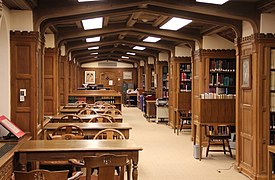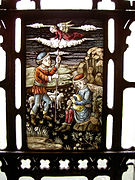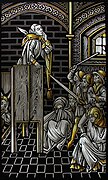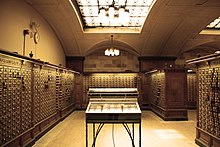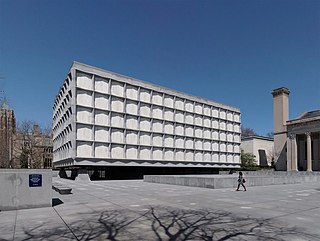
The Beinecke Rare Book & Manuscript Library is the rare book library and literary archive of the Yale University Library in New Haven, Connecticut. It is one of the largest buildings in the world dedicated to rare books and manuscripts and is one of the largest collections of such texts. Established by a gift of the Beinecke family and given its own financial endowment, the library is financially independent from the university and is co-governed by the University Library and Yale Corporation.

Saybrook College is one of the 14 residential colleges at Yale University.
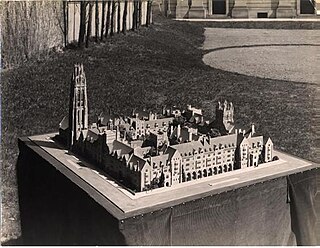
The Memorial Quadrangle is a residential quadrangle at Yale University in New Haven, Connecticut. Commissioned in 1917 to supply much-needed student housing for Yale College, it was Yale's first Collegiate Gothic building and its first project by James Gamble Rogers, who later designed ten other major buildings for the university. The Quadrangle has been occupied by Saybrook College and Branford College, two of the original ten residential colleges at Yale. The collegiate system of Yale University was largely inspired by the Oxbridge model of residential and teaching colleges at the University of Oxford and the University of Cambridge in the UK.

Branford College is one of the 14 residential colleges at Yale University.
G. Owen Bonawit (1891–1971) was an artist whose studio created thousands of pieces of stained glass for Yale, Duke, Northwestern, and Southeast Missouri State universities; Connecticut College; Bethesda By The Sea Episcopal Church in Palm Beach, Florida and at private homes. There are, by one count, 887 pieces in Yale's Sterling Memorial Library. Bonawit worked often and closely with the architect James Gamble Rogers. His career peaked around 1930; his last major commission was in 1940.

Collegiate Gothic is an architectural style subgenre of Gothic Revival architecture, popular in the late-19th and early-20th centuries for college and high school buildings in the United States and Canada, and to a certain extent Europe. A form of historicist architecture, it took its inspiration from English Tudor and Gothic buildings. It has returned in the 21st century in the form of prominent new buildings at schools and universities including Cornell, Princeton, Washington University, and Yale.

Berkeley College is a residential college at Yale University, opened in 1934. The eighth of Yale's 14 residential colleges, it was named in honor of Bishop George Berkeley (1685–1753), dean of Derry and later bishop of Cloyne, in recognition of the assistance in land and books that he gave to Yale in the 18th century. Built on the site of a group of buildings known from the 1890s until 1933 as the Berkeley Oval, the college was renovated in 1998. It is distinct for having two courtyards connected by an underground tunnel.

Jonathan Edwards College is a residential college at Yale University. It is named for theologian and minister Jonathan Edwards, a 1720 graduate of Yale College. JE's residential quadrangle was the first to be completed in Yale's residential college system, and was opened to undergraduates in 1933.

James Gamble Rogers was an American architect. A proponent of what came to be known as Collegiate Gothic architecture, he is best known for his academic commissions at Yale University, Columbia University, Northwestern University, and elsewhere.
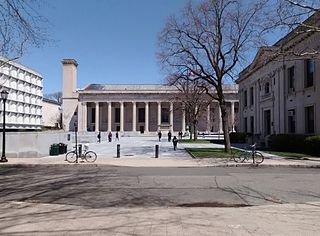
Hewitt University Quadrangle, commonly known as Beinecke Plaza, is a plaza at the center of the Yale University campus in New Haven, Connecticut. It is the home of the university's administration, main auditorium, and dining facilities. The quadrangle was created with the construction of the university's Bicentennial Buildings and Woodbridge Hall in 1901. Until 1917, it was known as University Court. The completion of the Beinecke Library created subterranean library facilities beneath the courtyard, establishing the present appearance of the paved plaza and sunken courtyard.
Manuscript Society is a senior society at Yale University in New Haven, Connecticut. It is reputedly the arts and letters society at Yale.

Connecticut Hall is a Georgian building on the Old Campus of Yale University. Completed in 1752, it was originally a student dormitory, a function it retained for 200 years. Part of the first floor became home to the Yale College Dean's Office after 1905, and the full building was converted to departmental offices in the mid-twentieth century. It is currently used by the Department of Philosophy, and its third story contains a room for meetings of the Yale Faculty of Arts & Sciences, the academic faculty of Yale College and the Graduate School.

The Lillian Goldman Law Library in Memory of Sol Goldman, commonly known as the Yale Law Library, is the law library of Yale Law School. It is located in the Sterling Law Building and has almost 800,000 volumes of print materials and about 10,000 active serial titles, in which there are 200,000 volumes of foreign and international law materials. The library was named after a US$20 million donation made by Lillian Goldman, widow of real estate magnate Sol Goldman.

The Yale University Library is the library system of Yale University in New Haven, Connecticut. Originating in 1701 with the gift of several dozen books to a new “Collegiate School," the library's collection now contains approximately 14.9 million volumes housed in fifteen university buildings and is the third-largest academic library system in North America and the second-largest housed on a singular campus.

The Anne T. & Robert M. Bass Library, formerly Cross Campus Library, is a Yale University Library building holding frequently-used materials in the humanities and social sciences. Located underneath Yale University's Cross Campus, it was completed in 1971 in a minimalist-functionalist style designed by Edward Larrabee Barnes. In 2007, Thomas Beeby led a multimillion-dollar renovation of the library that extensively reconfigured and refurbished its interior space.

The D. H. Hill Jr. Library is one of two main libraries at North Carolina State University. It is the third building to house the NC State University Libraries, following Brooks Hall and Holladay Hall. The current building, situated on the Hillsborough Street edge of North Campus, is the result of four stages of construction, and houses the majority of the volumes in NC State's collection.

The Princeton University Chapel is a Collegiate Gothic chapel located on that university's main campus in Princeton, New Jersey, United States. It replaces an older chapel that burned down in 1920. Designed in 1921 by Ralph Adams Cram in his signature style, it was built by the university between 1924 and 1928 at a cost of $2.3 million. The chapel was rededicated in an interfaith ceremony in 2002 following a major two-year restoration.
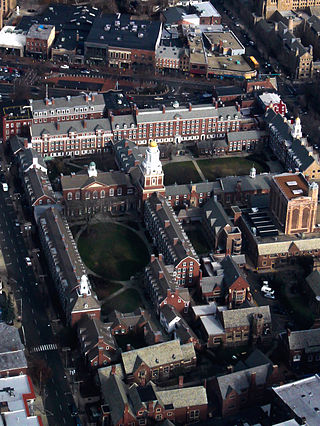
Yale University has a system of fourteen residential colleges with which all Yale undergraduate students and many faculty are affiliated. Inaugurated in 1933, the college system is considered the defining feature of undergraduate life at Yale College, and the residential colleges serve as the residence halls and social hubs for most undergraduates. Construction and programming for eight of the original ten colleges were funded by educational philanthropist Edward S. Harkness. Yale was, along with Harvard, one of the first universities in the United States to establish a residential college system.

Science Hill is an area of the Yale University campus primarily devoted to physical and biological sciences. It is located in the Prospect Hill neighborhood of New Haven, Connecticut.

The Main Library is a historic library on the campus of the University of Illinois Urbana-Champaign in Urbana, Illinois. Built in 1924, the library was the third built for the school; it replaced Altgeld Hall, which had become too small for the university's collections. Architect Charles A. Platt designed the Georgian Revival building, one of several on the campus which he designed in the style. The building houses several area libraries, as well as the University Archives and the Rare Book & Manuscript Library. The Main Library is the symbolic face of the University Library, which has the second largest university library collection in the United States.







